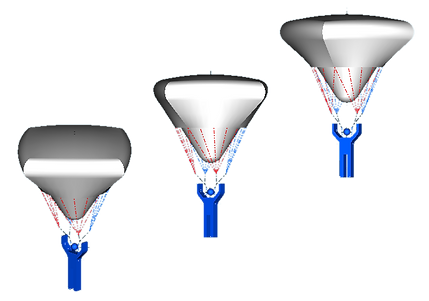

TPS
Tunneled Parachute System
Revolutionary vertical escage system for high-rise fire emergencies.

WHY TPS?
In today’s densely populated urban environments, traditional emergency escape methods primarily involve utilizing indoor egresses such as stairs and elevators, along with outdoor equipment like controlled descent devices, escape chutes, and platform rescue systems.
However, various factors—including smoke accumulation, the number of evacuees, and the hazards posed by flames and smoke, as well as potential power outages—can obstruct evacuation routes and complicate fire evacuation plans. Additionally, the higher the floor of a building (up to 1,000 meters), the more challenging a rescue operation becomes.
To tackle this challenge, the Tunneled Parachute System (TPS) has been developed as a non-structured, dependent evacuation solution. It is specifically designed to efficiently evacuate large numbers of individuals trapped in fire situations from heights ranging from as low as 15 meters up to as high as 1,000 meters.
Main Characteristics:
1. Pilot chute-free design - enhancing simplicity and ease of use
2. Jumping from heights as low as 15 meters – Before jumping, the TPS is inflated with air or helium to open the airflow inlet. After the jump, airflow from the tunnel pushes the canopy upward, achieving the descent velocity in 0.5 to 1 second.
3. Ultralight & rip-stop material - 20-40D, nylon 6/6 with silicone and airtight TPU coatings
4. Helium/air inflation balloon chamber - Design for self-rescue and UAV assisted-rescue tasks
5. Tunnel airflow guidance and ventilation - Effectively direct airflow to elevate the canopy.
6. Excellent stabilization - A cone-shaped balloon aligns its buoyancy center with the parachutist's weight for stable descent.
**Helium-inflated TPS (Tunneled Parachuting System)**
Helium-inflated TPS, a self-rescue solution to emergency fire, utilizes the buoyancy of helium to lift the entire escape equipment to a specific height. The system must also be equipped with a helium tank for inflation. Residents and workers in high-rise buildings are recommended to buy this system as a backup fire rescue device.
When an individual needing to escape puts on a safety harness and attaches a double-lock carabiner to the risers, they can safely jump from the windows to evacuate from a fire scene.
Helium-inflated TPS
H-TP-80 H-TP-110 H-TP-140
Action area of lifting force (m2)
18 25 34
Sink rate (m/s)
4.2 4.8 5.1
Inner pressure surface (m3)
42.8 50.4 66.6
Max. carrying Load (kg)
80 110 140
Device weight (kg)
4.0+1.0 4.6+1.2 5.4+1.4
Certification
EN&F EN&F EN&F
* The information in the table may change based on materials.
* Certification details are currently being processed.
**Air-inflated TPS (Tunneled Parachuting System)**
The air-inflated Tunneled Parachuting System (TPS), a self-rescue and assisted-rescue solution to emergency fire, is actuated with air to inflate a balloon and tubes, creating an air-flow tunnel for safe descent. The TPS comes with several accessories: (a) a compact air pump, (b) a hook for securing it to a window, and (c) a suction cup for inflation and additional attachment to window glass or frames.
Residents and workers in high-rise buildings are recommended to buy in this system as a backup fire rescue device.
Furthermore, the TPS is seamlessly integrated with GPS technology and dual-RTK delivery drones, allowing management centers and city fire departments to quickly deploy UAVs in response to SOS distress signals. This ensures that help arrives even if residents lack cell phones or fire escape devices.
Air-inflated TPS
A-TP-80 A-TP-110 A-TP-140
Action area of lifting force (m2)
18 25 34
Sink rate (m/s)
4.5 5.2 5.2
Inner pressure surface (m3)
42.8 50.4 66.6
Max. carrying Load (kg)
80 110 140
Device weight (kg)
1.5+1.0 1.9+1.2 2.4+1.4
Certification
EN<F EN<F EN<F
* The information in the table may change based on materials.
* Certification details are currently being processed.